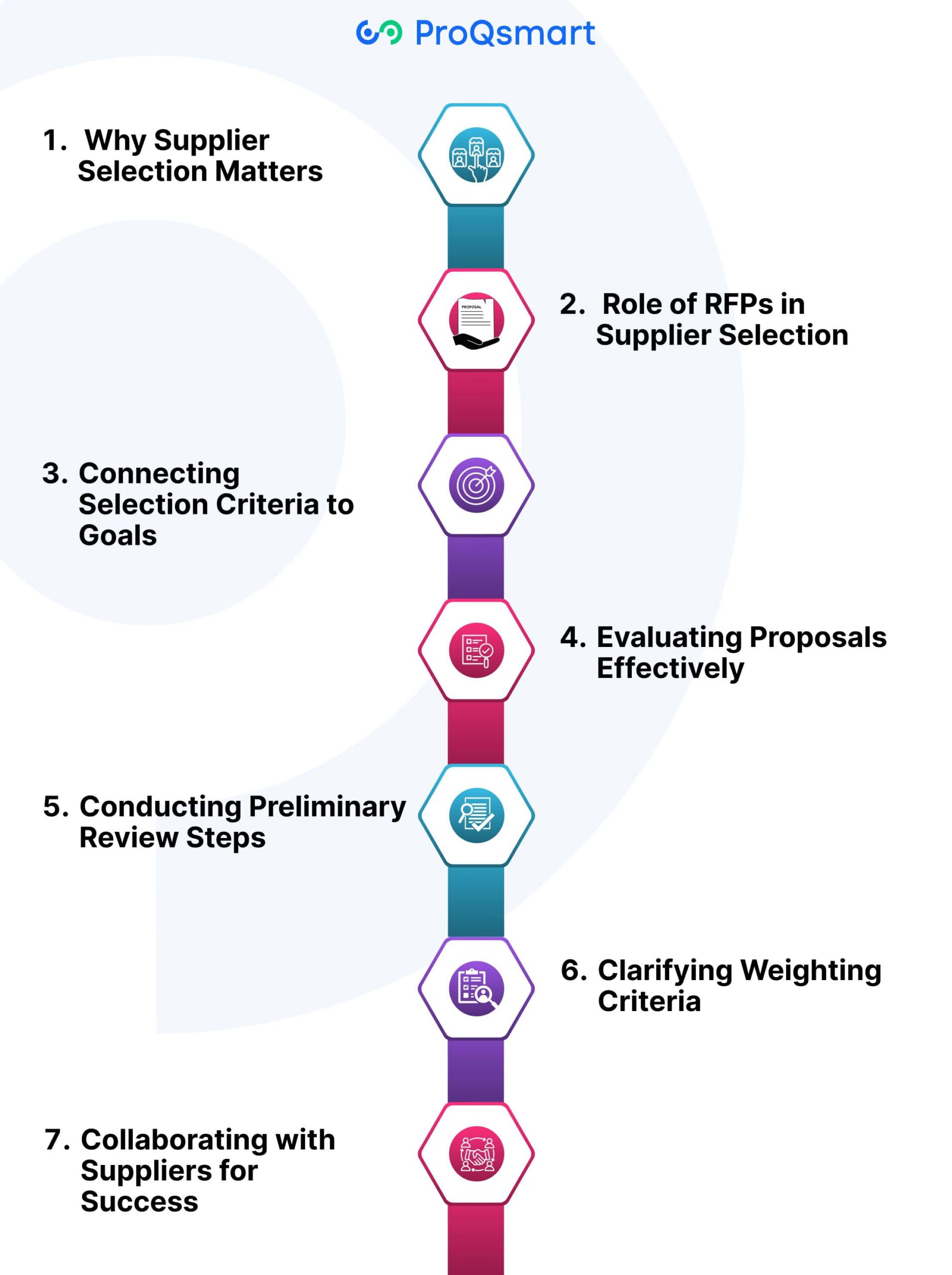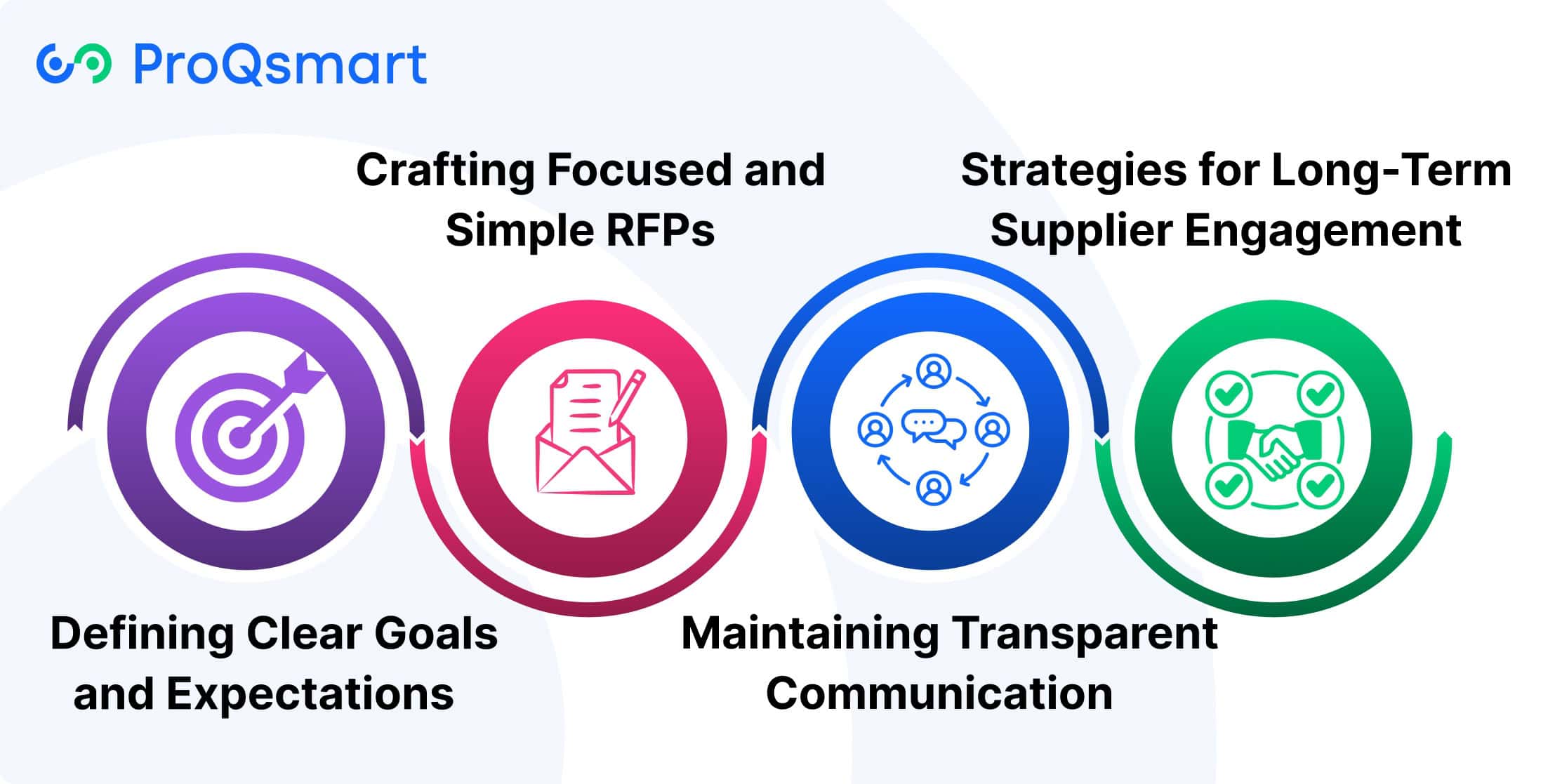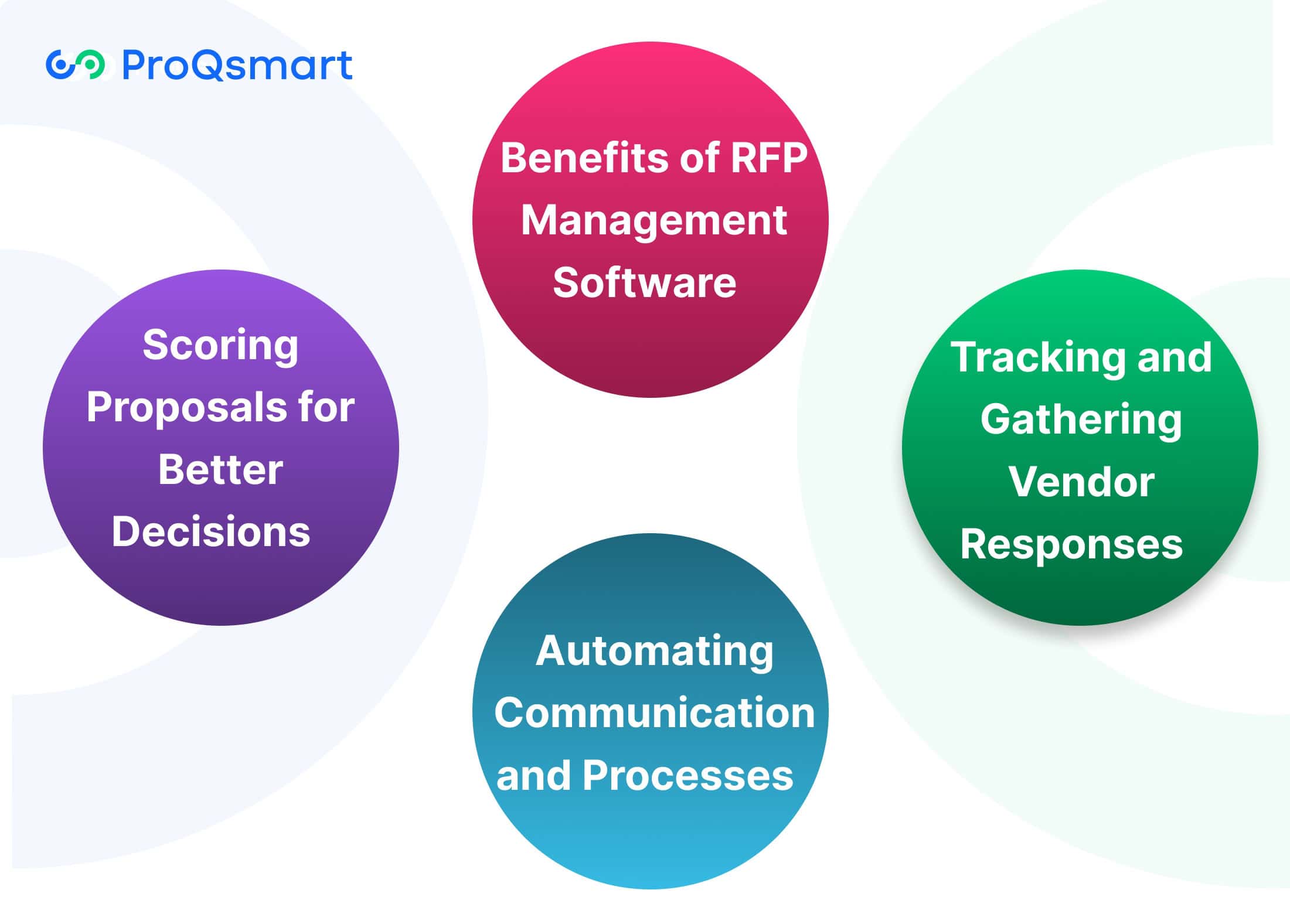An RFP, or Request for Proposal, is an important tool used by organizations. It describes the needs of the project and formally solicits and encourages the suppliers or vendors to bid on the project. This tool aids in the evaluation of prospective partners by allowing them to score themselves based on requirements that would best serve the need.
It ensures transparency and fairness at every step of the selection process. RFPs play an important role in the procurement process, enabling businesses to find the right vendors at the right price and successfully accomplish project goals. By establishing specific goals, deadlines, and measures of success, RFPs simplify the procurement process and reduce liability.
A good RFP process encourages collaboration. It creates market value for buyers and suppliers alike when procuring technology solutions, construction services, or any other products. Fulfilling the promise of procurement is all about understanding RFPs.
Importance of Supplier Selection

Supplier selection is a key foundation of procurement success, with far-reaching impacts on project success and the overall organizational mission. An intentional selection process ensures that the good or service will be delivered on-time. It further increases good use of time, money, and dependable, lasting outcomes.
By prioritizing reliable and capable suppliers, businesses can avoid disruptions, reduce risks, and secure a competitive edge in their industry.
1. Why Supplier Selection Matters
In fact, suppliers influence the success of daily business operations by the quality, reliability and timeliness of the products and services they provide. A reliable supplier supports even the most complex workflows without a hitch, while a subpar supplier can result in costly delays, escalated expenses, or loss of quality.
Aligning vendors to priorities such as sustainability or innovation through strategic supplier selection increases competitive advantage. A supplier with excellent integration capabilities can significantly accelerate operational efficiency. They do this by integrating smoothly with CRM or project management software to keep data consistent with minimal effort.
Poor supplier selection raises risks such as financial health, which can impact mission critical projects. Quality supplier relationships build trust and collaboration that create space for innovative solutions and even greater mutual success.
2. Role of RFPs in Supplier Selection
Request for Proposals (RFPs) provide an understandable and organized structure to compare the prospective suppliers. They save time in the selection process by clearly communicating needs and objectives, so only the most relevant vendors submit.
RFPs introduce transparency into vendor evaluations by offering standardized criteria for comparison, efficiently bringing suppliers into alignment with strategic goals. In this regard, ProQsmart streamlines the e-tendering process and allows real-time communication and collaboration to make sure that all vendors compete fairly.
This level of transparency builds trust and helps keep suppliers honest by ensuring they bring their most competitive proposals forward.
3. Connecting Selection Criteria to Goals
Financial viability of suppliers is crucial. Quality and reliability of the products or service supplied are also important. Vendor selection criteria should include integration capabilities with your existing tools and supplier performance history.
Customizing these criteria to the needs of an individual project helps create a more focused project that aligns with key business objectives. Having well-defined criteria makes proposals easier to evaluate, allowing organizations to find the vendors that best fit their priorities—whether that means saving money or improving sustainability, for example.
4. Evaluating Proposals Effectively
Best practices for proposal evaluations include using clear metrics, such as delivery timelines or past performance data. ProQsmart’s advanced analytics provide insights into vendor responses, refining future evaluations.
Objectivity, supported by collaboration among stakeholders, ensures fair assessments and minimizes biases.
5. Conducting Preliminary Review Steps
Use initial screenings to check for proposal completeness. Check your suppliers’ financial health. Look for warning signs such as poorly defined deliverables.
By involving a range of stakeholders in these reviews, you help bring in different perspectives, helping to mitigate the risk of oversight and strengthen decision-making.
6. Clarifying Weighting Criteria
Weighting criteria is important to identify which proposal priorities should take precedence. By developing a scoring system that transparently evaluates factors like cost, quality, and innovation, businesses can ensure alignment with objectives.
ProQsmart’s automated, multi-step workflows make this easy to achieve, ensuring consistent results and agreement among stakeholders.
7. Collaborating with Suppliers for Success
By instituting open lines of communication during the RFP process, you encourage collaboration among industry partners and applicants, resulting in innovative solutions. ProQsmart includes advanced tools like supplier relationship management and real-time collaborative review.
Armed with these tools, businesses of all sizes can create better relationships, drive down expenses, and succeed together.
Building Relationships Through RFPs

It’s more than just asking for bids; an effective RFP sets the stage for building deep, collaborative, and fruitful relationships with potential vendors. More than anything, clear communication and shared expectations are the keys to successful RFPs. Fostering opportunities for open dialogue could create a more solid foundation for mutually beneficial collaboration in the long run.
Defining Clear Goals and Expectations
Prior to issuing an RFP, it’s important to identify key objectives that will help achieve long-term meaningful outcomes for your organization. These might include identifying specific project requirements and deliverables, establishing budget constraints, prioritizing sustainability or compliance standards, and outlining timelines for project milestones.
Well-defined goals provide a roadmap throughout the drafting process, giving you direction and focus to make sure your RFP aligns with your priorities. Setting realistic expectations with future suppliers early on helps prevent any surprises down the road. For instance, if sustainability is a must-have, including that in the beginning makes it clear to all vendors so they can focus their proposals on that.
Having clear goals and expectations makes it easier to evaluate proposals, but it makes for a better chance at a successful project.
Crafting Focused and Simple RFPs
Simplicity in RFP documents is a win-win for buyers and vendors alike. A clear, well-structured RFP invites the most thoughtful responses by letting suppliers spend more time honing in on the most relevant solutions. Extremely detailed RFPs—some more than a thousand questions long—scare vendors away, making it difficult to get them involved and preventing a competitive result.
Build in time for creative responses to get past formulaic submissions. Beyond relationship building, focused RFPs are more efficient by cutting out unnecessary criteria upfront. Conducting a Request for Information (RFI) allows buyers to quickly narrow in on vendors who meet their most critical qualifications.
ProQsmart’s AI-powered platform helps ensure this process is seamless and efficient. This approach greatly reduces the complexity of the RFP process, leaving room to improve the odds of a strong match.
Maintaining Transparent Communication
Increased transparency throughout the RFP process fosters trust and goodwill with suppliers. Provide stakeholders with updates throughout the process, including during the evaluation stage. ProQsmart’s tools, like real-time collaboration and supplier performance monitoring, improve visibility and communication—all while building accountability.
When everyone is kept on the same page through open communication, the potential for risk and miscommunication is minimized.
Strategies for Long-Term Supplier Engagement
Building lasting supplier relationships requires strategic effort. Prioritize ongoing communication, even post-selection. Regularly evaluate supplier performance against contract terms. Collaborate to solve challenges and improve processes.
ProQsmart helps with this by automating workflows and allowing for quick, apples-to-apples comparisons of performance over time. These practices don’t just deepen relationships; they build an environment where both parties can flourish.
Effective Supplier Engagement Practices
Incorporating best supplier engagement practices during the RFP process sets the foundation for successful procurement outcomes. Procurement professionals hold the keys to stronger project performance through collaboration and ethical, sustainable procurement practices. This strategy is allowing them to develop more collaborative relationships with suppliers.
Putting these strategies into practice makes for a more efficient process that is in line with organizational missions as well as best practices of the industry.
Involving Key Stakeholders Early
Having all stakeholders involved from the start of the RFP process provides transparency, clarity, and alignment. Collaboration from the outset helps all teams to establish expectations, determine achievable goals, and evaluate project needs accurately.
Having project managers and end-users involved in the early conversations is key. It assists in making sure that their needs are taken into consideration in the proposal and reduces miscommunication.
Strategies like structured kick-off meetings and check-ins develop a common vision of goals and timelines and build accountability. Diverse perspectives make for better decision-making by revealing unforeseen risks or opportunities that may have otherwise been missed.
Practicing Ethical Procurement Methods
Ethical procurement practices are key to establishing trust and fairness in supplier relationships. Transparency in supplier selection, for instance, ensures that all vendors have equal opportunities to participate, leading to more competitive proposals.
Having clear evaluation criteria and consistent communication during the bidding process helps build accountability. Ethical practices build long-term relationships as they create an atmosphere of mutual respect and reliability.
ProQsmart technology ensures fair and accurate audits and prevents violations of the procurement process. This is critical in protecting the organization as well as its stakeholders.
Promoting Sustainable Supplier Practices
Sustainability is becoming an even more important driver in supplier engagement. Understanding how to select and measure suppliers’ use of environmentally responsible practices goes beyond simply meeting corporate social responsibility goals – it helps mitigate long-term risks as well.
Procurement teams can score suppliers with sustainability scorecards or certifications to determine which ones are focused on energy efficiency or reducing waste. By adding sustainability criteria into their RFPs, organizations will receive innovative eco-friendly solutions, leading to lower operational costs and a better brand reputation.
Using E-Sourcing Tools for Collaboration
E-sourcing tools make the RFP process easier, by automating workflows and allowing for collaboration in real-time. Tools from platforms like ProQsmart make it easier to submit proposals, keep track of subcontractor qualifications, and improve the monitoring of supplier performance.
By eliminating costly manual processes, these tools lead to improved communication and ultimately quicker, clearer results. Automating tasks like document tracking and bid scoring makes things more accurate and faster while increasing supplier engagement.
Leveraging Technology for RFPs and SRM

Using technology in the Request for Proposal (RFP) process makes workflows much more efficient and leads to better decisions. It improves communication and collaboration with suppliers, streamlining the entire RFP process. By addressing inefficiencies, compatibility issues, and data mismanagement, modern tools make a real impact.
This empowers procurement professionals to achieve real, measurable results, quickly and easily.
Benefits of RFP Management Software
RFP management software makes it easier to create, distribute, and evaluate proposals leading to quicker and more efficient processes. Features like automated templates, centralized document storage, and response tracking save time, remove manual errors, and decrease administrative burden.
For example, platforms like ProQsmart help organizations connect procurement to budgets while automating workflows. This provides a transparent, collaborative, and connected environment that boosts transparency and adherence to sourcing data.
Collaboration is even more improved with these platforms, helping suppliers easily access, submit, and edit proposals all in one place. With the help of responsive AI, teams can finish proposals 80% quicker. That added efficiency allows them to spend more time crafting strategies rather than getting mired in redundant work.
Additionally, monitoring RFP responses is a breeze, allowing procurement teams to track timelines and keep everything in order for more comprehensive evaluation.
Tracking and Gathering Vendor Responses
To track vendor responses effectively, thorough data collection needs to be performed and the right technology can make it seamless. Utilizing AI-powered tools, businesses can automatically store responses and analyze them in a systematic manner, making sure every detail is accounted for.
For instance, AI RFP software reduces response time by 10X and enables organizations to submit 67% more proposals each year. Data analytics takes this a step further, allowing for more focused decision-making.
Not only can high-performing vendors be identified, but valuable insights can be used to inform future RFI, RFQ, and RFP strategies. Centralized systems, such as ProQsmart, help to make vendor information management easier, while keeping the system compliant and cost-efficient.
Automating Communication and Processes
Automation cuts process time and errors drastically in the RFP process. Tools such as ProQsmart allow for easier vendor interactions, vendor workflow automation, and subcontractor pre-qualification management.
Automation helps streamline processes. Doing things the human way will always be more effective. Real-time collaboration tools make it so that relationships are bolstered, rather than replaced, by technology.
Scoring Proposals for Better Decisions
Objective scoring criteria are critically important to determine which vendor proposals will best meet the agency’s needs. AI-powered scoring systems ensure a standardized and impartial evaluation of all proposals, helping to pinpoint which vendors would best serve the organization’s priorities.
Once suppliers are on board, ProQsmart’s supplier performance monitoring keeps track of compliance with contract requirements to make future procurement choices more intelligent and proactive.
Conclusion
Objective scoring criteria are critically important to determine which vendor proposals will best meet the agency’s needs. AI-powered scoring systems ensure a standardized and impartial evaluation of all proposals, helping to pinpoint which vendors would best serve the organization’s priorities.
Once suppliers are on board, ProQsmart’s supplier performance monitoring keeps track of compliance with contract requirements to make future procurement choices more intelligent and proactive.
An RFP is not just a piece of paper. It’s a better approach to engaging with suppliers, creating value through collaborative relationships, and increasing innovation and performance. Selecting the best suppliers has the greatest impact on unit cost, design quality, and long-term project success. Positive partnerships are based on clearly defined expectations and mutual communication throughout the RFP process. Technology brings value by making all of this faster and more streamlined and informing better supplier management.
If you’re seeking to refine your RFP process further and maximize your procurement success, consider utilizing ProQsmart’s innovative solutions. Book a demo today to discover how ProQsmart can transform your RFP process into a streamlined, efficient operation that drives meaningful results.



